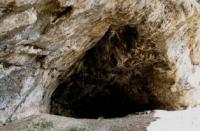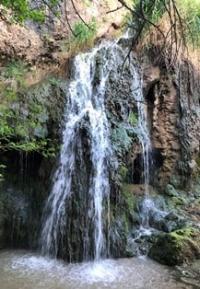You are here
Cave man site Karaungir.


Archaeological Caves of Southern Kazakhstan.
“I've known rivers:
I've known rivers ancient as the world and older than the flow of human blood in human veins. My soul has grown deep like the rivers”
Langston Hughes.
A trip to the cave of Karaungir from Turkestan.
Cave man site Karaungir dates back to V - IV century. BC. The cave is located 15 kilometers north of the village of Karaungir, on the right bank of the Karaungir river in the Baidibek district of Turkestan region. The cave was discovered and stationary studied by the South Kazakhstan Archaeological Expedition (Kh.A. Alpysbaev) in 1959.
Neolithic multilayer cave-type parking. It is located in a rocky vaulted grotto of gray limestones, at an altitude of 7 meters from the river bed. The size of the grotto: the entrance width is 20 - 25 meters, the arch height is 2 - 16 meters, the maximum length is 21 meters from the entrance to the southeast, 9 meters to the northeast.
The arch of the grotto in the center has a decrease to 1.5 meters. Cultural strata up to 5 meters thick have been identified. 2 main periods of functioning are distinguished: the lower layers with the remains of bonfires and the upper layers with a characteristic stone industry.
The most common tools: rounded elongated scrapers (large, small); plates with a side recess; drills, plates with blunt edges; cores, axes, knives, arrowheads. Everything is made of flint. Knife plates prevail in number.
Bone products: needles with an eye, an awl, punctures, ironers, tools from the scapular bones of animals. Tools were made on the spot from silicon, sandstone and rock crystal. Also found: bone gauge with divisions, drilled shells, cut wild boar fangs, various beads and pendants.
The basis of the economic activity of the ancient people of Karaungir was cattle breeding and hunting. This is evidenced by osteological material represented by the bones of a domestic bull, dog, kulan, bear, deer, gazelle, roe deer, wolf, partridge.
It belongs to the Neolithic time and characterizes the local South Kazakhstan version of the Neolithic material culture, associated on the one hand with monuments such as Achisayskaya and Valikhanovskaya sites, and on the other with cultural monuments.
Found, from the bone - a needle-shaped rod with 15 horizontal lines - divisions. The honor of opening the cave belongs to H.A. Alpysbaev. Cave parking Karaungur dates back to the neo-Stone Age - Neolithic. Findings in the Karaungir cave indicate that the ancient settlements of South Kazakhstan were able to count already in the Upper Paleolithic, and the skills of numerical operations they acquired were passed down from generation to generation, over time, becoming more sophisticated and more complicated.
Karaungur also gave the material traditional for such localities - hearths and campfires, and next to them - the bones of a bear, deer, wild bull, argali, wild boar, hare and badger, pheasant and partridge. Stone tools, arrowheads, and crafts made of bone were also found.
Round-bottom ceramic vessels, coated with red paint and ornamented with a toothed stamp, were also found. Finds of Neolithic utensils are rare for the South of Kazakhstan, which, along with other artifacts, put the cave site Karaungir in a number of unique archaeological sites in our country.
Authority:
"Religious and spiritual monuments of Central Asia." Author M. Khashimov. Saga Publishing House, 2001. www.farsah.kz. "Ancient Kazakhstan" Arias, Saki, Huns, Turks. Children's Encyclopedia of Kazakhstan. Almaty, 2007, Aruna Publishing House. Medoev A.G.,. Magauin M. Alphabet of Kazakh history. Documentary narration. Almaty, "Kazakhstan", 1997.
Photos
Alexander Petrov.







